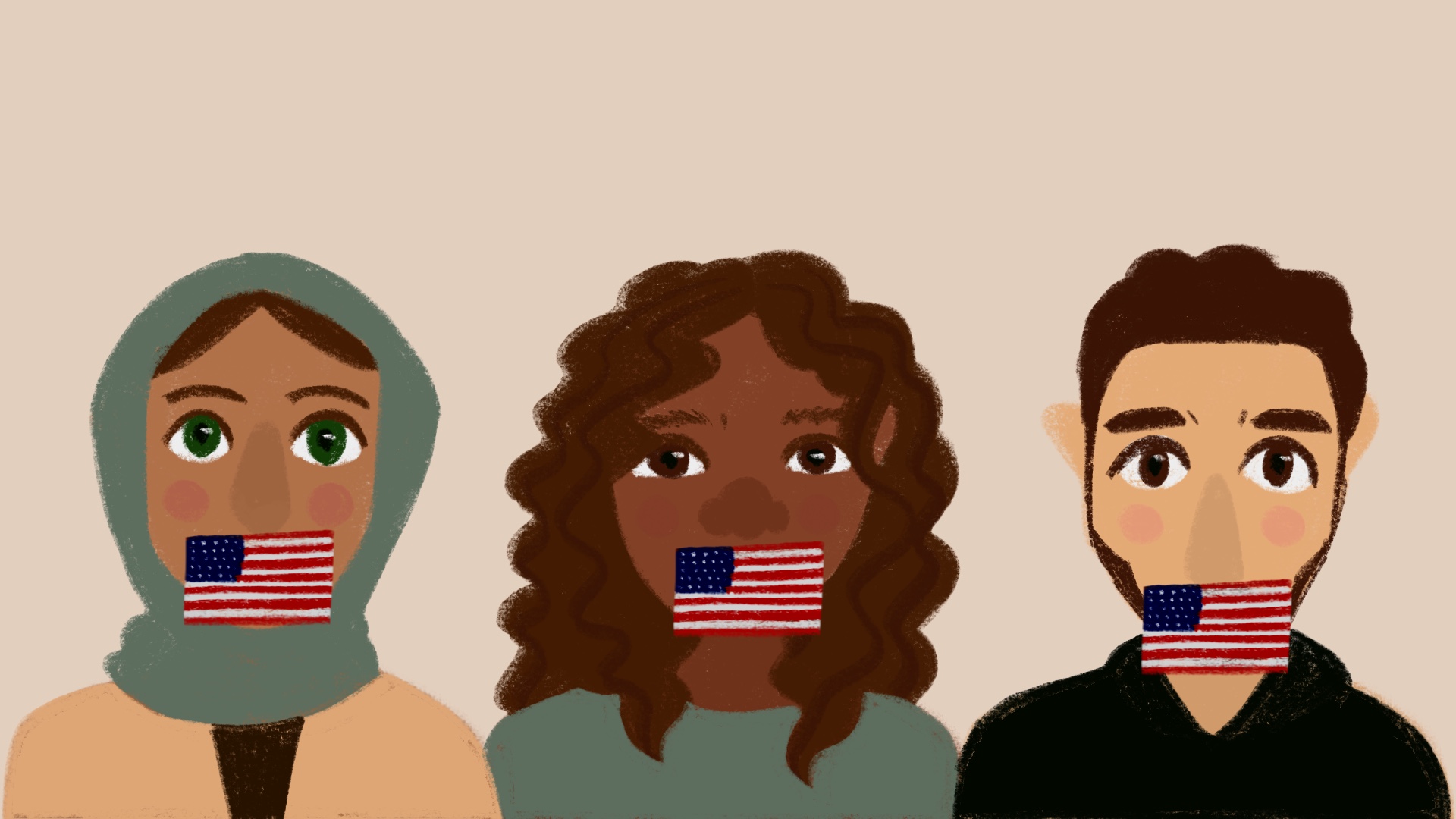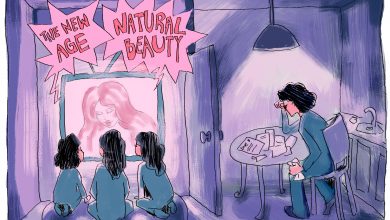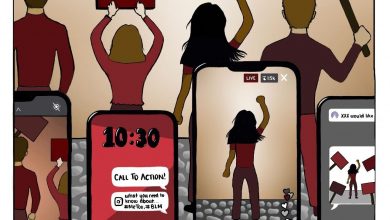America’s Distorted Perception of West Asia and West Asian People

Image Description: Three West Asian people standing in front of a beige background with United States flags covering their mouths.
“Middle Eastern” has been my identity for as long as I can remember. When I was younger, I associated it with tabbouleh, strict parents, rhythmic and delicate dances, unbreakable faith, and above all, a permanent sense of pride and adoration for my people. It didn’t take long to discover that outside of my tight-knit Armenian community, the United States had branded the Middle East as a region that needed to be saved from its own terrorism.
The term “Middle East” originated during Britain’s imperial invasion of India. Initially, the territory was first divided into the “Near East,” or the eastern Mediterranean, and the “Middle East” which consisted of the land near the Persian Gulf; after the collapse of the Ottoman Empire the distinction between the two was no longer relevant, and the entire region was considered the “Middle East.” The expression was then popularized by an American naval strategist as a name for the region between Arabia (the land between the Red Sea and Persian Gulf) and India, and became widely used in the West during and after the World Wars. Unsurprisingly, a large number of the world’s superpowers now refer to the region using a term that is not only vague in regard to borders, but also centralizes Europe and the Americas.
Fortunately, geographically neutral terms are becoming increasingly popular, as scholars and politicians are beginning to refer to the territory as West Asia or Southwest Asia and North Africa, commonly abbreviated as SWANA.
While the American census continues to include the term “Middle Eastern,” the shortcomings of the United States do not begin and end with how the SWANA region is classified. The American people and government also engage in discriminatory treatment against West Asians and problematically generalize the inhabitants of the region. Typically, Americans associate the SWANA region with Islam, terrorism, and fascism; it is a common misconception that everyone from the SWANA region is ethnically Arab. Not only do these implications serve as racist justifications of the U.S.’s invasion and destruction of the region, but they also imply that the West Asian population is a monolith ethnically and religiously. While the region is approximately 80% Muslim and 60% Arab, these American perceptions erase and disregard non-Arabs and non-Muslims living in and originating from SWANA, and generally dismiss the astonishing diversity of West Asian identities and cultures.
In regard to culture, West Asia was the birthplace of the three most practiced monotheistic religions: Christianity, Islam, and Judaism. Consequently, all the three are practiced in the region, and contrary to popular belief, Islam does not have a monopoly over religion in West Asia. West Asia is also home to numerous language families which consist of Arabic, Aramaic, Armenian, Kurdish, Turkish, Hebrew, and Persian. Even Arabic, the most widely spoken language in the region, has incredibly distinct dialects within West Asian communities.
The West Asian region consists of approximately 20 countries, all of which exhibit a myriad of physical attributes, religion, language and other aspects of culture and national identity. The stereotypical image of a West Asian individual includes brown skin, dark eyes, and dark hair. Maybe it’s for this reason that I, a lighter-skinned, green-eyed, curly-haired brunette, am often told that I, “don’t look Middle Eastern.” In reality, the SWANA region is inhabited by people whose skin ranges from pale to dark brown, whose eye color is no more likely to be brown than blue or green, and whose hair naturally presents as brown, red, or blonde.
Therefore, it is unreasonable and destructive to perpetuate the notion that one combination of physical attributes or cultural characteristics can be used to describe all of West Asia. Ironically, Americans are sometimes able to use the overwhelming diversity of the region to their advantage, classifying us under any umbrella term that fits their agenda for any particular reason. This can include using our “whiteness” to invalidate our experiences as people of color in the United States, or our “brownness” to demonize us and justify the violence and brutality we encounter in our homelands.
Because many people originating from SWANA are lighter-skinned, the American government can successfully misrepresent us as racially “white” at their convenience. Currently, the United States census defines white as, “A person having origins in any of the original peoples of Europe, the Middle East, or North Africa.” Not only does this definition force darker skinned West Asians to classify themselves as white, but it employs the use of the previously-discussed colonial term, “Middle East.”
Maybe it’s because of the American government’s definition of “white” that American people insist that our self-identification aligns with their perception of our race. During October of last year, Armenians took to Twitter in hopes of raising awareness of Azerbaijan’s attempts to ethnically cleanse Armenians from their indigenous land of Artsakh. Unnervingly, the American response overwhelmingly consisted of variations of “We have more important issues,” and “You’re white, how can you be oppressed?”
The word Caucasian originally referred to those from the Caucasus mountain range in West Asia, but was manipulated to refer to phenotypically white people. People who are ethnically Caucasian (Turks, Armenians, Georgians, and Azeris) are further invalidated due to the 18th century eugenics of racial classification, which resulted in the generalization of West and Central Asians and Europeans as members of the “white” race in order to differentiate them from East Asians and Africans. As a remnant of the continued misuse of the term “Caucasian,” Americans with European origins have not only inappropriately claimed the label, but further weaponize it to assert “whiteness” upon individuals with Caucasian roots. Worse yet, the misrepresentation of the Caucasian people results in members of other West Asian populations refusing to claim Armenians, Turks, Georgians, and Azeris as West Asian.
Similarly, Afghans are incessantly ridiculed on social media when speaking on their experiences as people of color, and the comment sections are flooded with individuals from the United States insisting that they must identify as white due to their physical attributes. Yet, after the Taliban successfully took over Afghanistan, Afghans conveniently became “othered” as brown people once again. Ultimately, in cases where our ethnic issues are not deemed important enough to be discussed, our “whiteness” is used as an excuse for Americans to remove themselves from the conversation. At other times, our “brownness” is used to either victimize or demonize our communities.
There exists the perception that SWANA is a territory infested with war and destruction, yet many fail to realize that the United States is one of the most significant contributors to the dismantling of any political stability or peace that exists in the region. While the United States government propagates its own brand of terrorism within the region, carrying out drone strike after drone strike and funding multiple genocides against West Asian minorities, West Asian people living in America are constantly told we should be grateful for any intervention of the United States, as if our people are being “liberated” from the corrupt, incompetent governing powers in our homelands. Are Armenians meant to be grateful for the United States’s recognition of the Armenian genocide as the U.S. militarily aids Azerbaijan in their genocide attempts? Are Afghans meant to credit American soldiers who terrorized Afghanistan under the guise of “fighting terrorists,” after the United States played such an instrumental role in the rise of the Taliban in the first place?
While the white-washing of West Asian people takes place on a systemic level, we also experience invalidation and microaggressions in our everyday interactions. Our traumas and experiences are often dismissed due to the fact that they are not identical to the oppressive experiences other non-white peoples face in the United States. But oppression is not a cookie-cutter issue; discrimination against West Asians takes the form of slurs, such as sand kisser, sand n-word, towelhead, and terrorist. In addition, we tend to become very well acquainted with the TSA every time we fly internationally or domestically. Every day after an ISIS attack in a European country or American state, our parents are harassed at work while we are harassed on high school and college campuses. If you’re lucky like me, your parents will name you Ovsanna, which isn’t too dissimilar from Osama, and eventually you will become the punch line of every 9/11 joke.
Southwest Asian and North African identities are conveniently pushed and pulled between white and brown and manipulated in order to fit the American perception of a particular group of people at any particular point in time. SWANA people are constantly told how we should identify, as our own perception of our identities is rarely echoed in conversations regarding West Asian racial dynamics. Our struggles and causes are merely an afterthought to the American government and people, as the constant invasion of U.S. forces in West Asia is frequently discussed during presidential elections, then mostly disregarded for another four years. Furthermore, American citizens conveniently turn a blind eye to their own government’s culpabilities, claiming that U.S-funded West Asian genocides or wars are not America’s to extinguish.




